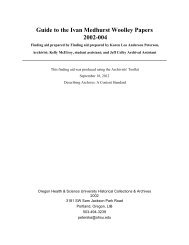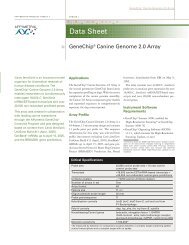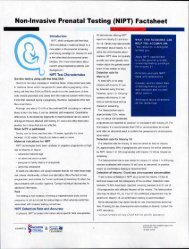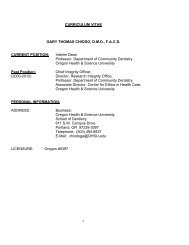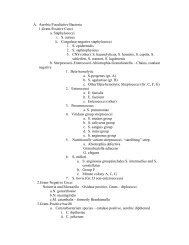1962;29;121-128 Pediatrics T. Berry Brazelton A CHILD-ORIENTED ...
1962;29;121-128 Pediatrics T. Berry Brazelton A CHILD-ORIENTED ...
1962;29;121-128 Pediatrics T. Berry Brazelton A CHILD-ORIENTED ...
Create successful ePaper yourself
Turn your PDF publications into a flip-book with our unique Google optimized e-Paper software.
approach in the group of parents in our<br />
study could divert some of their own an<br />
xiety, provided there was the “¿guiding earâ€<br />
of a third person, such as the pediatrician.<br />
The conviction that this was “¿better for the<br />
child†undoubtedly acted as a counter<br />
balance to the older cultural influences, as<br />
well as to their own sexuabized taboos in<br />
this area. Since the child's autonomous<br />
achievement was constantly the focus,<br />
there was the implication that there was<br />
less parental responsibility for failure in<br />
the child's lack of accomplishment. Ten<br />
sion could be reduced by airing parental<br />
conflicts and by assurance that the child<br />
would achieve control in his own time.<br />
PROCEDURE<br />
Advice was geared to each individual<br />
situation. At the 9-month visit the question<br />
of future toilet training was raised with the<br />
parents. Because the grandparents' genera<br />
tion usually began to press them at this<br />
time, it has proven to be an optimal period<br />
for the discussion of future plans in this<br />
area. With a program planned, the parents<br />
were better able to withstand outside pres<br />
sure to institute an early attempt at train<br />
ing the child.<br />
Before suggestions were introduced, the<br />
parents' own feelings in this highly-charged<br />
area were explored. A repeated opportunity<br />
for them to express their own resistances<br />
and anxieties about toilet training was fin<br />
portant in preventing their expressing them<br />
unconsciously to the child. The importance<br />
of a relaxed, unpressured approach to train<br />
ing for the child was constantly stressed.<br />
This method was presented as an adjunct<br />
to helping the child meet society's demands<br />
in this area. Because there is little innate<br />
in the child that leads him to want to be<br />
clean and dry, it must be understood as a<br />
kind of compliance to external pressure.<br />
The act of giving up the instinctual method<br />
of wetting and soiling to comply is evidence<br />
of 1) healthy maturation in the child,<br />
coupled with 2) a wish to identify with an<br />
adult society.17 Hence the optimal timing<br />
for such pressure must be geared to each<br />
child's physical and psychological readiness<br />
ARTICLES 123<br />
to cooperate. With his autonomous achieve<br />
ment of this major task, the reward for him<br />
is equivalent to that seen with his mastery<br />
of standing and walking and becomes a<br />
valuable step in his developmental prog<br />
ress. The danger of residual symptoms is<br />
then at a minimum.<br />
The importance of timing the introduc<br />
tion of this method to the child's readiness,<br />
and of allowing him freedom to master<br />
each step at his own pace, was reiterated<br />
at each subsequent visit. Problems with<br />
the child and resistances or questions from<br />
the parent were discussed at each oppor<br />
tunity. Since this was not necessarily an<br />
attempt to prejudice parents for this par<br />
ticular approach to toilet training, every<br />
effort was made to help them with their<br />
own method. However, when problems<br />
arose, the child's interests were placed fore<br />
most in the discussion.<br />
Method of Training<br />
At some time after the child is 18 months<br />
of age, a “¿potty chairâ€on the floor is intro<br />
duced as the child's “¿own chair.†During<br />
the period of getting familiar with it, as<br />
sociation between it and the parents' toilet<br />
seat is made verbally. At some routine<br />
time, the mother takes him each day to sit<br />
on his chair in all his clothes. Otherwise,<br />
the unfamiliar feeling of a cold seat can<br />
interfere with any further co-operation. At<br />
this time, she sits with him, reads to him or<br />
gives him a cookie. Since he is sitting on a<br />
chair on the floor, he is free to leave at<br />
will. There should never be any coercion<br />
or pressure to remain.<br />
After a week or more of his co-operation<br />
in this part of the venture, he can be taken<br />
for another period with hia diapers off, to<br />
sit on the chair as the routine. Still no at<br />
tempt to “¿catch†his stool or urine is made.<br />
“¿Catching†his stool at this point can<br />
frighten him and result in his “¿holding<br />
backâ€for a longer period thereafter. This<br />
gradual introduction of the routine is made<br />
to avoid setting up fears of strangeness and<br />
of loss of “¿part of himself.â€<br />
When his interest in these steps is<br />
achieved, he can be taken to his pot a sec<br />
Downloaded from<br />
www.pediatrics.org by Cynthia Ferrell on April 15, 2011






